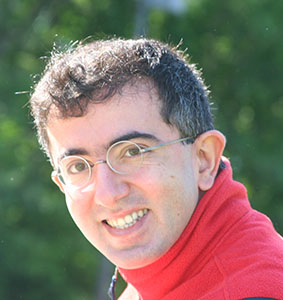
Mehmet Kayaalp, MD, PhD
Applied Clinical Informatics Branch
Staff Scientist
mkayaalp@mail.nih.gov
Expertise and Research Interests:
Mehmet Kayaalp's work focuses on computational linguistics, machine learning and probabilistic graphical models on the domain of medical informatics. He has published a number of articles on each of these subjects. He leads NLM efforts on de-identifying narrative clinical reports.
Dr. Kayaalp started working on biomedical informatics projects in the mid-1980s during his medical education at the University of Istanbul, from which he received his MD. He pursued his interest in biomedical informatics as a research scholar at Southern Methodist University in Dallas, Texas. He later matriculated at SMU, where he earned an MS in Computer Science, and successfully completed his PhD coursework and doctoral exams. Toward his dissertation work, he worked on an Office of Naval Research-funded computational linguistics project, developing various probabilistic linguistic models based on Markov random field theory. Upon the departure of his advisor from SMU, Dr. Kayaalp moved to the University of Pittsburgh, where he worked with Drs. Gregory F. Cooper and Bruce G. Buchanan on Bayesian networks and machine learning in various biomedical informatics projects. He received his Ph.D. degree in Intelligent Systems from University of Pittsburgh with a specialization in Biomedical Informatics.
Dr. Kayaalp has worked on various software engineering projects during his career but his main interest has remained artificial intelligence. In the 1990s, he developed the concept of multifaceted ontological networks, by recognizing the fact that everyone cannot agree on a single scientific or philosophic view of the world, but multiple views and interpretations of the same world have to coexist and compete for the progress of science and culture. The method of multifaceted ontological networks is a means to cope with the exponential growth of scientific information. It proposes a systematic organization of scientific information from various disciplines through a non-ambiguous formalism of logic without excluding any particular scientific observation or interpretation of the world.
Professional Activities:
Dr. Kayaalp was appointed as the physician and the chief medical officer to a transportation regiment, where he managed the operation of an Army clinic supervising other medical and Army personnel. In the early 1990s, he worked as a research scholar in the Department of Computer Science and Engineering at Southern Methodist University, Dallas, Texas. During his studies in computer science, he worked at SMU in various academic capacities including teaching and research positions. In University of Pittsburgh, he worked at the Center for Biomedical Informatics, (currently known as the Department of Biomedical Informatics), where he participated as a research assistant to the Integrated Advanced Information Management Systems project funded by National Library of Medicine.
Publications:
Kayaalp M. Modes of De-identification. AMIA Annu Symp Proc. 2018 Apr 16;2017:1044-1050. eCollection 2017.Kayaalp M. Patient Privacy in the Era of Big Data. Balkan Med J. 2018 Jan 20;35(1):8-17. doi: 10.4274/balkanmedj.2017.0966. Epub 2017 Sep 13.
Kayaalp M, Browne AC, Sagan P, McGee T, McDonald CJ. Challenges and Insights in Using HIPAA Privacy Rule for Clinical Text Annotation. AMIA Annu Symp Proc. 2015 Nov 5;2015:707-16. eCollection 2015.
Kayaalp M, Browne AC, Dodd ZA, Sagan P, McDonald CJ. An Easy-to-Use Clinical Text De-identification Tool for Clinical Scientists: NLM Scrubber [Poster]. Proceedings of the Annual American Medical Informatics Association Fall Symposium: 1522.
Szolovits P, Aberdeen J, Meystre S, Kayaalp M. Panel on: State of the Art of Clinical Narrative Report De-Identification and Its Future [Poster]. . Proceedings of the Annual American Medical Informatics Association Fall Symposium: 240–242.
Kayaalp M, Browne AC, Dodd Z, Sagan P, McDonald CJ. De-identification of Address, Date, and Alphanumeric Identifiers in Narrative Clinical Reports. AMIA Annu Symp Proc. 2014 Nov 14;2014:767-76. eCollection 2014.
Browne AC, Kayaalp M, Dodd Z, Sagan, P, McDonald CJ. The Challenges of Creating a Gold Standard for De-identification Research. AMIA Annu Symp Proc. 2014 Nov 14;2014:353-8. eCollection 2014.
Huser, V, Kayaalp M, Dodd Z, Cimino J. Piloting a deceased subject integrated data repository and protecting privacy of relatives. AMIA Annu Symp Proc. 2014 Nov 14;2014:719-28. eCollection 2014.
Ozturk S, Kayaalp M, McDonald CJ. Visualization of patient prescription history data in emergency care. AMIA Annu Symp Proc. 2014 Nov 14;2014:963-8. eCollection 2014.
Kayaalp M, Browne AC, Callaghan FM, Dodd Z, Divita G, Ozturk S, McDonald CJ. The pattern of name tokens in narrative clinical text and a comparison of five systems for redacting them. J Am Med Inform Assoc. 2014 May-Jun;21(3):423-31. doi: 10.1136/amiajnl-2013-001689. Epub 2013 Sep 11.
Kayaalp M, Browne AC, Dodd Z, Sagan P, McDonald CJ. Clinical Text De-Identification Research. September 2013 Technical Report to the LHNCBC Board of Scientific Counselors.
Fung K, Kayaalp M, Callaghan FM, McDonald CJ. Comparison of electronic pharmacy prescription records with manually collected medication histories in an emergency department. Ann Emerg Med. 2013 Sep;62(3):205-11. doi: 10.1016/j.annemergmed.2013.04.014. Epub 2013 May 18.
Kang YS, Kayaalp M. Extracting laboratory test information from biomedical text. J Pathol Inform. 2013 Aug 31;4:23. doi: 10.4103/2153-3539.117450. eCollection 2013.
Kayaalp M. ICU Outcome Predictions using Physiologic Trends in the First Two Days. Computing in Cardiology (39)977–980.
He Y, Kayaalp M. Biological Entity Recognition with Conditional Random Fields. AMIA Annu Symp Proc. 2008 Nov 6:293-7
Kayaalp M. Separation of Data, Interpreters and Likelihood. March 2007 Technical Report to the LHNCBC Board of Scientific Counselors.
He Y, Kayaalp M. Interpretation of Data and Identification of Information are Sine Qua Non for Modern Digital Information Services. AMIA Annu Symp Proc. 2006:946
He Y, Kayaalp M. A Comparison of 13 Tokenizers on MEDLINE. December 2006 Technical Report.
Gay CW, Kayaalp M, Aronson AR. Semi-Automatic Indexing of Full Text Biomedical Articles. AMIA Annu Symp Proc. 2005:271-5
Kayaalp M. Why Do We Need Probabilistic Approaches to Ontologies and the Associated Data?. AMIA Annu Symp Proc. 2005:1005
Kayaalp M. Bayesian Methods for Diagnosing Physiological Conditions of Human Subjects from Multivariate Time Series Biosensor Data. Physiological Data Modeling Contest, the Twenty-First International Conference on Machine Learning (ICML), 2004 July.
Kayaalp M. Modeling and Learning Methods; A Report to the Board of Scientific Counselors. May 2004 Technical Report to the LHNCBC Board of Scientific Counselors.
Buchanan BG, Chapman W, Cooper GF, Hanbury P, Kayaalp M, Ramachandran M, Saul M. Creating a Software Tool for the Clinical Researcher - the IPS System. Proc AMIA Symp. 2002: : 1210.
Cooper GF, Buchanan BG, Chapman W, Hanbury P, Kayaalp M, Saul M. IPS: A System That Uses Machine Learning to Help Locate Patient Records for Clinical Research. Proc AMIA Symp. 2001: : 813.
Kayaalp M, Cooper GF, Clemont G. Predicting ICU mortality: a comparison of stationary and nonstationary temporal models. Proc AMIA Symp. 2000:418-22.
Aronis JM, Cooper GF, Kayaalp M, Buchanan BG. Identifying patient subgroups with simple Bayes'. Proc AMIA Symp. 1999:658-62.
Cooper GF, Buchanan BG, Kayaalp M, Saul M, Vries JK. Using computer modeling to help identify patient subgroups in clinical data repositories. Proc AMIA Symp. 1998:180-4.


